Behind-the-scenes look inside one of the world's biggest slaughterhouses by Alastair Philip Wiper
Photo essay: British photographer Alastair Philip Wiper toured the interior of one of the largest slaughterhouses in the world to create this series of images documenting how pigs are turned into pork, sausages and bacon (+ slideshow).
Danish Crown is the world's largest exporter of pork, killing approximately 100,000 pigs a week to cater to the growing global demand for meat.
Alastair Philip Wiper visited the company's abattoir in Horsens to capture a behind-the-scenes look at the entire process, starting at the pens where the pigs arrive and moving through the spaces where the animals are slaughtered, butchered and packaged for sale.
Wiper says he "finds it difficult to tolerate those who love eating meat, but cannot bear to think about, or look at, the slaughter and death of that animal", so each image in the Danish Crown Slaughterhouse is intended to reveal the entire butchering process, made visible by the transparency and openness of the spaces.
I am not a squeamish person. I love food, I love meat, and I particularly love pork.
In an ideal world, we would all get our meat from the guy in our village whose family has lovingly cared for their animals over generations, given the animals the best possible life, fed them only the best food, read them a bed-time story every night and given them kilometres of space to roam free in before being humanely and ceremoniously slaughtered by the patriarch of the family.
Unfortunately most of us don't live in that world, and while there is a strong case for a serious discussion about whether or not we really need to eat, or should be eating, as much meat as we do, that is a discussion for another day.
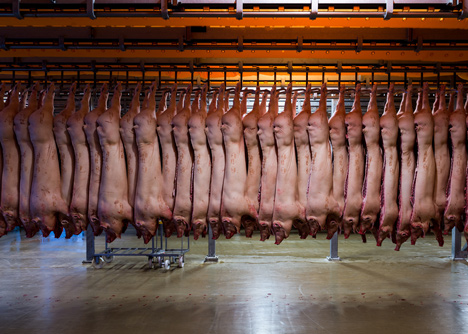
The reality is that the society we live in craves meat, on a massive scale. Where there is a demand there will be a supply, and finding out how that supply is met is something that all meat-eaters should be interested in. As a food lover, I am firmly of the belief that people should think about, understand and respect their food (that includes vegetables!) and part of that respect is rooted in where the meat on your plate comes from and how it died.
I find it difficult to tolerate those who love eating meat, but cannot bear to think about, or look at, the slaughter and death of that animal. It seems disrespectful towards the animal, and if I wanted to get really eggy about it, I'm not sure if such people should be allowed to eat meat at all. So it was with great anticipation that I looked forward to my visit to the Danish Crown slaughterhouse in Horsens, touted as "the most modern slaughterhouse in the world".
Danish Crown is the world's largest exporter of pork, supplying pork to customers all over the world; 90 percent of the pork slaughtered in Denmark is exported, with the UK being the biggest market.
Completed in 2004, the slaughterhouse at Horsens kills approximately 100,000 pigs per week, making it one of the largest in the world. There are 1,420 people employed there, and the slaughterhouse receives around 150 visitors per day.
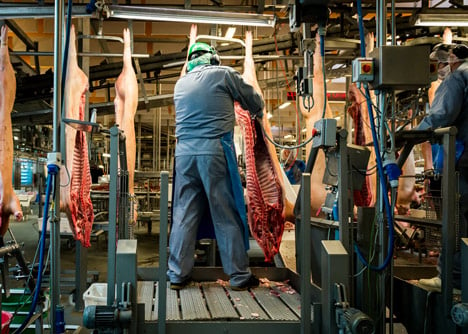
The slaughterhouse has been designed with openness in mind; a viewing gallery follows every step of the production, from the pigs arriving, to the slaughter itself, to the butchering and packaging. I was genuinely surprised at the level of openness at the plant; Danish Crown wants to invite people in and say "look, this is how we do it".
The first part of the process is called the "black" slaughter line, and is in stark contrast with the minimalist, office-like corridors that surround the slaughtering area. We started off in the space where the pigs arrive - holding pens where up to 3,800 pigs (three and a half hours worth of slaughtering) will sit for one to two hours before they are slaughtered.
"Listen to that" says my guide, Agnete Poulsen. "Listen to what?" I think. "There are thousands of pigs in here, and you can hardly hear a sound. Have you ever heard the noise that 10 pigs can make? It's incredible. These are very calm pigs, and that’s the way we want them to be. This room has been designed to calm the pigs down before they go into the slaughterhouse. If the pigs are stressed when they are killed, the quality of the meat will not be so good."
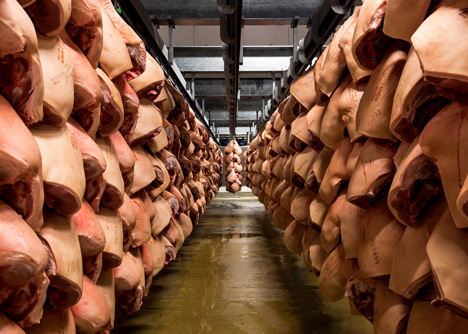
From there, the pigs are gently herded in small groups by a series of moving walls into a gas chamber, where they are rendered unconscious by C02 gas. A minute later, they tumble out of the chamber on to a conveyor belt from where they are strung up by their legs before being stuck in the carotid artery and bleeding to death.
The pigs continue on their journey along a long line, strung up by their legs. They disappear into a cabinet, where an automatic saw chops their body in half. Then a series of workers remove different organs from each side of the body - one lucky guy's job is to remove the brain, the next one the heart, and so on.
Needless to say, there is a lot of blood. As I mentioned earlier, I believe it is important to understand how an animal is butchered, and even try it yourself; but, I think to myself, I couldn't do this for a living. "Do you psychologically profile the guys who do these jobs? How do you know they won't crack up after a couple of weeks?" I ask Agnete. "Not at all" she replies. "They get used to it very quickly. You would too. We don’t force people to do this, they are happy to do it. It’s an honest job."
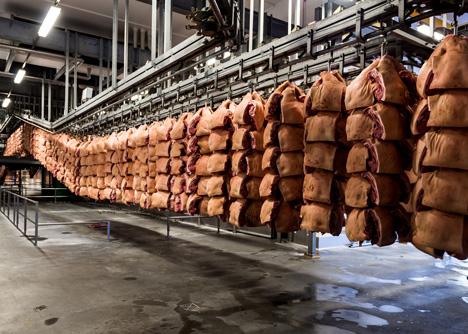
All of the organs collected in this process move on to different sections of the plant where they will be processed further – there is always a part of the world where something we don’t eat here is a delicacy. From the "black" slaughter line, the pigs are hung for 16 hours in a refrigerated room, before moving on to the next line for general butchering by hand, then packaging, before being loaded on to trucks and whizzed off to far-flung places. At each step of the process, different parts of the pig are stamped, scanned and recorded, so that each piece of meat in the supermarket can be traced right back to the farm that it came from and the time it was slaughtered.
The slaughterhouse at Horsens was truly one of the most fascinating places I have visited on my travels. It is an experience that will leave a mark on my daily life, and help me to understand, just a little, about another important aspect of my food.
As you can probably tell, this is not an in-depth exposé of an industry, and my experience is not enough to knowledgeably critique the process of delivering Danish Crown bacon to your breakfast table; nor can I account for the processes of Danish Crown outside what I saw in Horsens. But I was pleasantly surprised by the openness of the plant about its operations and methods, and it is clear that when they designed the slaughterhouse they were thinking ahead in terms of what consumers will want to see from food producers: more transparency.
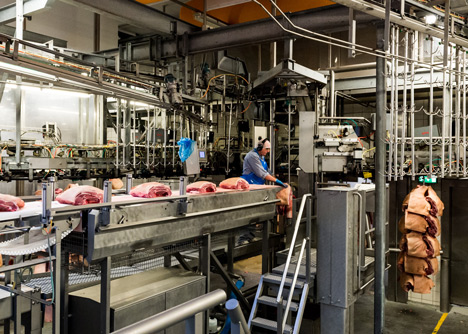
And while I can't comment on the conditions of the lives of the pigs before they get to the slaughterhouse (the vast majority of which come from Denmark), I can only make an educated guess that, through my own experience as a resident of Denmark, the laws that govern the treatment of pigs would be about as strict or stricter as they would be anywhere else in the world. Anyone with any knowledge on that would be welcome to chip in. I am happy to admit that I finished my tour with a sausage in the canteen.